
Chemists at MIT have discovered a way to fortify iodine salt with iron, resulting in a product that, if made widely available, could combat one of the world’s most prevalent nutrient deficiencies.
A bout 2 billion people suffer from iron deficiency, which can lead to anemia, impaired brain development in children, and increased infant mortality. The richest sources are all animal foods, which tend to be more expensive and less available.
Plant sources are more difficult to absorb, and many plants contain phytates that block iron absorption altogether. Challenges with fortifying food staples have long existed with iron, not least because what might be a stable in Papua New Guinea is not a stable in the southern United States.
Attempting to grapple with the problem, MIT researchers have come up with a new way to fortify foods and beverages with iron using small crystalline particles. These particles, known as metal-organic frameworks, could be sprinkled on food, added to staple foods such as bread, or incorporated into drinks like coffee and tea.
“We’re creating a solution that can be seamlessly added to staple foods across different regions,” says Ana Jaklenec, a principal investigator at MIT’s Koch Institute for Integrative Cancer Research, in a release from MIT Press.
“Our goal was to develop something that doesn’t react with the food itself. That way, we don’t have to reformulate for every context—it can be incorporated into a wide range of foods and beverages without compromise.”
Food fortification can be a successful way to combat nutrient deficiencies, but this approach is often challenging because many nutrients are fragile and break down during storage or cooking. When iron is added to foods, it can react with other molecules in the food, giving the food a metallic taste.
In previous work, Jaklenec’s lab has shown that encapsulating nutrients in polymers can protect them from breaking down or reacting with other molecules. In a small clinical trial, the researchers found that women who ate bread fortified with encapsulated iron were able to absorb the iron from the food.
The particles could also be adapted to carry other important minerals such as zinc, calcium, or magnesium. However, one drawback to this approach is that the polymer adds a lot of bulk to the material, limiting the amount of iron or other nutrients that end up in the food.
“Encapsulating iron in polymers significantly improves its stability and reactivity, making it easier to add to food,” Jaklenec said. “But to be effective, it requires a substantial amount of polymer. That limits how much iron you can deliver in a typical serving, making it difficult to meet daily nutritional targets through fortified foods alone.”
To overcome that challenge, study co-author and MIT postdoc Xin Yang came up with a new idea, Instead of encapsulating iron in a polymer, they could use iron itself as a building block for a crystalline particle known as a metal-organic framework, or MOF.
MOFs consist of metal atoms joined by organic molecules called ligands to create a rigid, cage-like structure. Depending on the combination of metals and ligands chosen, they can be used for a wide variety of applications.
ALSO CHECK OUT: Wheat Grown with This Fungus Increased its Essential Mineral Content–a Breakthrough Preparation
“We thought maybe we could synthesize a metal-organic framework with food-grade ligands and food-grade micronutrients,” Yang says. “Metal-organic frameworks have very high porosity, so they can load a lot of cargo. That’s why we thought we could leverage this platform to make a new metal-organic framework that could be used in the food industry.”
Iodized salt has been very successful at preventing iodine deficiency, and as a result is sold around the world. Many efforts are now underway to create “double-fortified salts” that would also contain iron.
Delivering these nutrients together has proven difficult because iron and iodine can react with each other, making each one less likely to be absorbed by the body. In this study, the MIT team showed that once they formed their iron-containing MOF particles, they could load them with iodine, in a way that the iron and iodine do not react with each other.
NUTRIENTS MATTERS: Popping a Daily Multivitamin Could Prevent Cognitive Decline as we Age, Shows Third Study
In tests of the particles’ stability, the researchers found that the iron-iodine MOFs could withstand long-term storage, high heat and humidity, and boiling water.
Throughout these tests, the particles maintained their structure. When the researchers then fed the particles to mice, they found that both iron and iodine became available in the bloodstream within several hours of consumption.
The researchers are now working on launching a company that is developing coffee and other beverages fortified with iron and iodine. They also hope to continue working toward a double-fortified salt that could be consumed on its own or incorporated into staple food products.
MORE IRON SOLUTIONS: To Fortify With Iron, Ingenious Metal Fish Soaked in Soup Provides Nutrition And is Much Cheaper Than Pills
“We are very excited about this new approach and what we believe is a novel application of metal-organic frameworks to potentially advance nutrition, particularly in the developing world,” says Robert Langer, the David H. Koch Institute Professor at MIT who co-lead the research.
The paper on their discovery has been published in the journal Matter.
SHARE This Great News For Combatting Nutrient Deficiency…

